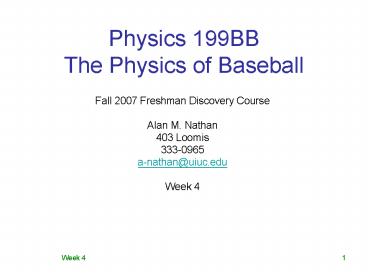Physics 199BB The Physics of Baseball PowerPoint PPT Presentation
1 / 27
Title: Physics 199BB The Physics of Baseball
1
Physics 199BBThe Physics of Baseball
- Fall 2007 Freshman Discovery Course
- Alan M. Nathan
- 403 Loomis
- 333-0965
- a-nathan_at_uiuc.edu
- Week 4
2
Forces on a Baseball in Flight
- Gravity
- Already discussed
- Drag (air resistance) Force
- Already discussed
- Magnus Force
- Now we do this
3
The Magnus Force
Courtesy, Popular Mechanics
- ball deflects air
- air must deflect ball in opposite direction
- (Newtons 3rd Law)
- size of FM proportional to ?
4
Recall our definitions
- ? is angular velocity
- a measure of how fast the ball is spinning
- units are rad/s or rev/min (rpm)
- to convert from rad/s to rpm
- multiply by 60/(2?)
- to convert from rpm to rad/s
- divide by 60/(2?)
- ? has a direction
5
The spin axis is the line connecting the south to
north pole (right-hand rule)
spin axis
6
The Magnus ForceThe magnitude of FM
- FM ½CL?Av2
- CL is the lift coefficient
- CL CM(R?/v)
- FM ½CM?AR?v
- CM is the Magnus coefficient
- A dimensionless number
7
The Magnus ForceSome numerology
FM ½CM?AR?v plug in know values of ?,A,R
8
The Magnus ForceNumerical Examples
- v50 mph, ? 1800 rpm, CM 1
- FM/mg 0.276
- v100 mph, ? 1800 rpm, CM 1
- FM/mg 0.552
- See Adair, Fig. 2.2, page 12
9
The Magnus ForceThe direction of FM
- Force acts in the direction
- another right-hand rule
- force is perpendicular to both v and ?
- force acts in the direction that the leading edge
of the ball is turning
10
Some Qualitative Effects of the Magnus Force
- Backspin makes ball rise
- hop of fastball
- undercut balls increased distance, reduced
optimum angle of home run - Topspin makes ball drop
- 12-6 curveball
- topped balls nose-dive
- Breaking pitches due to spin
- Cutters, sliders, etc.
11
Additional Effects
Balls hit to left/right curve toward foul pole
12
Additional Effects
- Tricky trajectories of popups
- --popup behind home plate with lots of backspin
13
Incorporating Magnus into Excel
- We now have a 3-dimension problem
- For our first examples, we will only consider
2-dimensional problems - topspin or backspin, but no sidespin
14
Case 1 Backspin
- FMx -FM sin(?)
- FMy FM cos(?)
- aMx -2.09 x 10-6 CM?vg sin(?) -2.09 x 10-6
CM?gvy - aMy 2.09 x 10-6 CM?vg cos(?) 2.09 x 10-6
CM?gvx
15
Case 2 Topspin
y
- FMx FM sin(?)
- FMy -FM cos(?)
- aMx 2.09 x 10-6 CM?gv sin(?) 2.09 x 10-6
CM?gvy - aMy -2.09 x 10-6 CM?gv cos(?) -2.09 x 10-6
CM?gvx
?
?
FM
x
16
Now look at the filetrajectory-drag-Magnus-2da.x
ls
- Batted balls
- Low initial angles
- range increases
- angle for maximum range decreases
- trajectory more asymmetric
- Higher initial angles
- range decreases
- trajectory more symmetric
- cusps and loops
17
Now look at the filetrajectory-drag-Magnus-2db.x
ls
- Pitched balls
- Backspin reduces drop (fastball)
- Topspin increases drop (curveball)
18
How do we know what CM is?
- An Experiment Done At UIUC
19
Tracking The Trajectory
Motion Capture System--Beckman
20
- Motion Capture System
- 10 cameras
- 700 frames/sec
- 1/2000 shutter
- very fancy software
- www.motionanalysis.com
- Pitching Machine
- project horizontally
- 50-110 mph
- 1500-4500 rpm
21
Typical Data
22
Trajectory data (top) for one of the pitches
projected, where y and z are the coordinates of
the dot on the ball in the coordinate system
shown in the inset. The ball is projected at a
slight upward angle to the z direction and is
spinning clockwise (topspin) about an axis
perpendicular to y-z plane. Solid curves are
least-square fits to the data using Eq. 4,
resulting in CD 0.44 and CL 0.33. The long
dashed curve is the center-of-mass trajectory for
the y coordinate, which is consistent with a
downward acceleration of 1.58g due to the
combined effects of gravity and the Magnus force.
The short dashed curves are the
center-of-masscoordinates for both y and z with
both CD and CL set to zero, indicating that the
data are very sensitive to CL but not to CD.
23
Results for Lift Coefficient CL
FM 1/2?ACLv2 Sr?/v CM CL/S 100
mph, 2000 rpm ?S0.17
24
Results for Drag Coefficient CD
FD 1/2?ACDv2
Conclusion Major disagreements for v 70-100
mph
25
Data Do Not Agree with Adair
- Experimental Data CM ? 1 for S0.1-0.3
- For 2000 rpm, S0.1-0.3 corresponds to 57-171 mph
- For 1000 rpm, range is 85 to 255 mph
- So, most of interesting range is covered
- Adair (see p. 24)
- For 2000 rpm
- CM0.8 at 50 mph-agrees with data (0.8)
- CM0.4 at 100 mphtoo low (1.1)
- I have written a paper about this (see web site)
26
Now lets include sidespin
- z is third dimension, points to pitchers right
- Lets look at pitched ball only
- Spin axis lies in y-z plane
- ?0 for backspin, 180 for topspin
- ?90 or 270 for pure sidespin
27
Here are the formulas
y
spin axis
FM
- FMx FM sin (?)vz/v-cos(?)vy/v
- FMy FM cos (?)vx/v
- FMz -FM sin(?)vx/v
- aMx2.09x10-6 CM?g sin(?)vz-cos(?)vy
- aMy2.09x10-6 CM?gcos(?)vx
- aMz-2.09x10-6 CM?gsin(?)vx
- Notes
- when ? is 0 or 180, these formulas are identical
to the ones previously used - Since v?vx, FMx?0
- FMy is responsible for up/down break
- (max when ?0 or 180)
- FMz is responsible for left/right break
- (max when ?90 or 270)
- 5. FM makes angle ?90 with z axis
?
z
batters view

